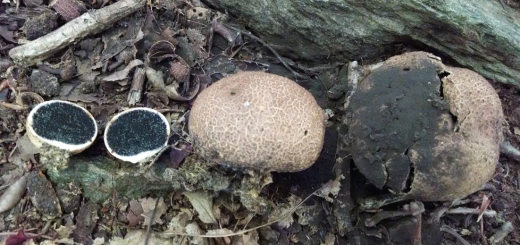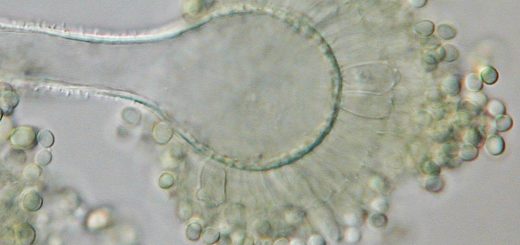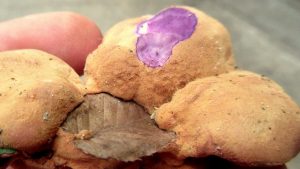#059: Tremella mesenterica, Witch’s Butter [Archived]
Note: This is an archived post. You can find the current version of this post here.
Legend has it that witches use this fungus to cast hexes. When this fungus appears on your gate or door, you have certainly been the victim of a witch’s evil spell. The only way to counter the hex is to pierce the fungus with straight pins, allowing the inner juices to drain and thus killing the fungus and the spell. Unfortunately for those who believe this superstition, this method probably doesn’t work too well for two reasons. First, the mushroom is specifically designed to survive repeated dehydration and rehydration. Second, the main body of the fungus is still living inside the wood. Unless you replace the wood you will probably find the mushroom repeatedly fruiting from the same place.
Witch’s Butter also goes by a variety of other common names, including Yellow Brain Fungus and Tripe Fungus. The scientific name (Tremella mesenterica) translates to “trembling middle intestines.” From these descriptive names you can probably get an idea of what Witch’s Butter looks like: a yellow, squishy, lobed, wavy, and otherwise irregular blob. T. mesenterica is a common jelly fungus that is found fruiting from dead wood. The species is widely distributed in North America, Europe, and elsewhere. The gelatinous texture allows the fruiting body to produce spores in wet weather while surviving long, dry periods. When completely dried out, the fruiting body is an inconspicuous, tough crust on its wooden substrate.
Like other members of the Tremellales, Witch’s Butter does not decompose wood, but is instead parasitic on wood-decomposing fungi. T. mesenterica seems to have a preference for crust fungi in the genera Peniophora and Stereum. Aside from their unusual consistency, the Tremellales are different from most basidiomycetes in an important way: they have septate basidia. The spore-bearing cells (basidia) of the Tremellales are split into four separate cells by interior cell walls called septa. In the Tremellales, the septa are arranged vertically. Their basidia are therefore called cruciate septate basidia, since the septa form a “+” shape when looked at from above. Each section of the basidium produces a long sterigma, which bears a single spore. These basidia are fascinating to look at under the microscope, but are very hard to see because they are embedded in a gelatinous matrix. T. mesenterica shares one more unusual characteristic with its relatives: it has a yeast phase. In the absence of its host, the fungus tends to grow as individual yeast cells rather than as connected hyphae. This is usually only problematic for mycologists who are trying to study the fungus. Even if they remember not to throw out the yeast, the fungus does not survive for very long without a suitable host.
There does not seem to be consensus about whether or not Witch’s Butter is edible. T. mesenterica is nonpoisonous, so it’s really up to the individual to decide if the flavorless fungus is worth eating. Like the Snow Fungus (Tremella fuciformis, see FFF#023), Witch’s Butter would be eaten for its texture rather than its taste.
See Further:
http://botit.botany.wisc.edu/toms_fungi/oct2000.html
http://www.mushroomexpert.com/tremella_mesenterica.html
http://www.sierrapotomac.org/W_Needham/Witches’Butter_070205.htm
http://mdc.mo.gov/discover-nature/field-guide/witches-butter
http://www.first-nature.com/fungi/tremella-mesenterica.php
http://www.fcps.edu/islandcreekes/ecology/witches_butter.htm (sparse information, but good pictures)

![#019: Apiosporina morbosa, Black Knot of Cherry [Archived]](https://www.fungusfactfriday.com/wp-content/themes/hueman/assets/front/img/thumb-medium-empty.png)







![#011: Characteristics of Kingdom Fungi [Archived]](https://www.fungusfactfriday.com/wp-content/themes/hueman/assets/front/img/thumb-small-empty.png)



1 Response
[…] encountered jelly fungi are found in the Tremellomycetes. These include the Witch’s Butter (Tremella mesenterica) and the edible Snow Fungus (Tremella fuciformis, see FFF#023). Tremellomycetes are pathogens of […]